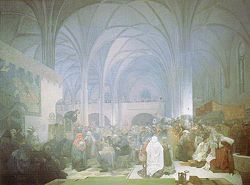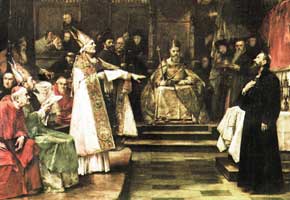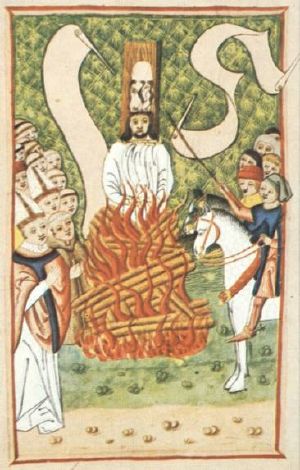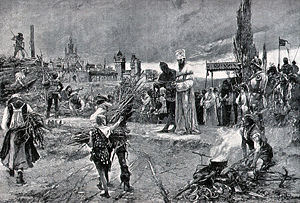Difference between revisions of "Jan Hus" - New World Encyclopedia
(import category and credit) |
m (→Papal schism: link) |
||
| Line 12: | Line 12: | ||
The University of Prague around 1408 was being torn apart by the ongoing [[Western Schism|papal schism]], in which [[Pope Gregory XII]] and [[Avignon Pope Benedict XIII]] both laid claim to the papacy. | The University of Prague around 1408 was being torn apart by the ongoing [[Western Schism|papal schism]], in which [[Pope Gregory XII]] and [[Avignon Pope Benedict XIII]] both laid claim to the papacy. | ||
| − | King Wenceslaus felt Pope Gregory XII might interfere with his plans to be crowned [[Holy Roman Emperor]]; thus, he renounced Gregory and ordered his [[prelate]]s to observe a strict neutrality toward both [[pope]]s, and said he expected the same of the university. [[Zbyněk Zajíc|Archbishop Zbyněk Zajíc]] remained faithful to Gregory, however, and at the university it was only the "Bohemian nation" (one of four voting blocs), with Hus as its leader and spokesman, which avowed neutrality. | + | King Wenceslaus felt Pope Gregory XII might interfere with his plans to be crowned [[Holy Roman Empire|Holy Roman Emperor]]; thus, he renounced Gregory and ordered his [[prelate]]s to observe a strict neutrality toward both [[pope]]s, and said he expected the same of the university. [[Zbyněk Zajíc|Archbishop Zbyněk Zajíc]] remained faithful to Gregory, however, and at the university it was only the "Bohemian nation" (one of four voting blocs), with Hus as its leader and spokesman, which avowed neutrality. |
===Kutná Hora=== | ===Kutná Hora=== | ||
Revision as of 20:40, 27 June 2006
Jan Hus (listen ▶) (IPA: [ˈjan ˈɦus]), also known as John Huss (c. 1369 - 1415) was a Czech (living in the area then known as Bohemia) religious thinker, philosopher, and reformer, master at Charles University in Prague. His followers became known as Hussites. The Roman Catholic Church considered his teachings heretical, and Hus was excommunicated in 1411, condemned by the Council of Constance, and burned at the stake on July 6, 1415, in Konstanz (aka Constance), Germany.
Hus was a precursor to the Protestant movement. His extensive writings earn him a prominent place in Czech literary history. He is also responsible for introducing the use of diacritics (especially the inverted hat - háček) into Czech spelling in order to represent each sound by a single symbol. Today, a statue of Jan Hus can be seen at the Prague old town square, the Staroměstské náměstí.
Jan Hus Day (Den upálení mistra Jana Husa) on July 6, the anniversary of the execution of Jan Hus, is one of the public holidays in the Czech Republic.
Early life and studies
John Hus was born at Husinec (75 km s. s. w. of Prague) in or around the year of 1369.
Papal schism
The University of Prague around 1408 was being torn apart by the ongoing papal schism, in which Pope Gregory XII and Avignon Pope Benedict XIII both laid claim to the papacy.
King Wenceslaus felt Pope Gregory XII might interfere with his plans to be crowned Holy Roman Emperor; thus, he renounced Gregory and ordered his prelates to observe a strict neutrality toward both popes, and said he expected the same of the university. Archbishop Zbyněk Zajíc remained faithful to Gregory, however, and at the university it was only the "Bohemian nation" (one of four voting blocs), with Hus as its leader and spokesman, which avowed neutrality.
Kutná Hora
In response, Wenceslaus, at the instigation of Hus and other Bohemian leaders, issued in Kutná Hora a decree that the Bohemian nation should now have three votes (instead of one) in all affairs of the university, while the foreign nations, principally Germany, should have only one vote. As a consequence somewhere between five and twenty thousand German doctors, masters, and students left the university in 1409, going on to found the University of Leipzig, among others. Thus Prague lost its international importance and became a Czech school, though the emigrants spread news of the Bohemian heresies throughout the rest of Europe.
The archbishop became isolated and Hus was at the height of his fame. He became the first rector of the Czech university, and enjoyed the favor of the court. In the meantime, the doctrinal views of the English theologian John Wycliffe had spread throughout Bohemia.
Alexander V becomes Pope
In 1409, in an attempt to end the papal schism, the Council of Pisa met to elect a new pope who would usurp the other two. This did not succeed, and the pope they elected, Alexander V, did not end loyalty to the other two; he is now considered an antipope. However, Hus and his followers, in addition to King Wenceslaus, transferred their allegiance to Alexander V. Under pressure from Wenceslaus, archbishop Zbyněk eventually did the same. The archbishop then brought his complaints before Alexander V's papal see, accusing the Wyclifites of ecclesiastical disturbances.
Excommunication of Hus
Alexander V issued his papal bull of December 20, 1409, which empowered the Archbishop to proceed against Wyclifism — all books of Wycliffe were to be given up, his doctrines revoked, and free preaching discontinued. After the publication of the bull in 1410, Hus appealed before Alexander V, but in vain; all books and valuable manuscripts of Wycliffe were burned, and Alexander V excommunicated Hus and his adherents. Riots ensued in parts of Bohemia.
The government took the side of Hus, and the power of his adherents increased from day to day. He continued to preach in the Bethlehem chapel (a church building in Prague), and became bolder and bolder in his accusations against the Church. The churches of the city were put under the ban, and the interdict was pronounced against Prague, but without result.
Indulgences
Archbishop Zbyněk Zajíc died in 1411, and with his death the religious movement in Bohemia entered a new phase — the disputes concerning indulgences arose.
Crusade Against Naples
In 1411, antipope John XXIII, who had become Alexander V's successor a year earlier after Alexander's death, issued a crusade against King Ladislaus of Naples, the protector of Gregory XII. This crusade was preached in Prague as well, and preachers of indulgences urged people to crowd the churches and give their offerings, developing a traffic in indulgences.
Condemnation of Indulgences and Crusade
Hus, following the example of Wycliffe, spoke out against indulgences and wrote his famous crusade. But he could not carry with him the men of the university. In 1412 a dispute took place, on which occasion Hus delivered his Quaestio magistri Johannis Hus de indulgentiis. It was taken literally from the last chapter of Wycliffe's book, De ecclesia, and his treatise, De absolutione a pena et culpa. The pamphlet stated that no pope or bishop had the right to take up the sword in the name of the Church; he should pray for his enemies and bless those that curse him; man obtains forgiveness of sins by real repentance, not through money.
The doctors of the theological faculty replied, but without success. A few days afterward some of Hus's followers, led by Vok Voksa z Valdštejna, burnt the papal bulls; Hus, they said, should be obeyed rather than the Church, which they considered a fraudulent mob of adulterers and Simonists.
Response
In response, three men from the lower classes who openly contradicted the preachers during their sermons and called indulgences a fraud were beheaded; they were later considered the first martyrs of the Hussite Church. The theological faculty asked Hus to present his speeches and doctrines to the dean for an examination, but he refused.
In the meantime, the faculty had condemned the forty-five articles anew and added several other heretical theses which had originated with Hus. The king forbade the teaching of these articles, but neither Hus nor the university complied with the ruling, requesting that the un-scriptural nature of the articles should be first proven.
Further dissentions
The tumults at Prague had stirred up a sensation, unpleasant for the Roman party; papal legates and Archbishop Albik tried to persuade Hus to give up his opposition to the papal bulls, and the king made an unsuccessful attempt to reconcile the two parties.
Call for arrest of Hus
In the meantime the clergy of Prague, through Michael de Causis, had brought their complaints before the Pope, and he ordered the Cardinal of St. Angelo to proceed against Hus without mercy. The cardinal put him under the great church ban. He was to be seized and delivered to the archbishop, and his chapel was to be destroyed. This was followed by stricter measures against Hus and his adherents, and in turn counter-measures of the Hussites, including an appeal by Hus that Jesus Christ, and not the Pope, was the supreme judge. This intensified the excitement among the people, and Wenceslaus forced Hus to leave Prague, but his departure did little to quell the ongoing excitement.
Attempted reconcilliation
The king, being grieved by the disrepute of his country on account of the heresy, made great efforts to harmonize the opposing parties. In 1412 he convoked the heads of his kingdom for a consultation, and at their suggestion ordered a synod to be held at Český Brod on February 2, 1412. It did not take place there, but in the palace of the archbishops at Prague, in order to exclude Hus from participation.
Propositions were made for the restitution of the peace of the Church, Hus requiring especially that Bohemia should have the same freedom in regard to ecclesiastical affairs as other countries and that approbation and condemnation should therefore be announced only with the permission of the state power. This is wholly the doctrine of Wycliffe (Sermones, iii. 519, etc.). There followed treatises from both parties, but no harmony was obtained. "Even if I should stand before the stake which has been prepared for me", Hus wrote at the time, "I would never accept the recommendation of the theological faculty." The synod did not produce any results, but the King ordered a commission to continue the work of reconciliation.
The doctors of the university required from Hus and his adherents an approval of their conception of the Church, according to which the Pope is the head, the Cardinals are the body of the Church, and that all regulations of this Church must be obeyed.
Hus protested vigorously against this conception since it made Pope and cardinals alone the Church. Nevertheless the Hussite party seems to have made a great effort toward reconciliation. To the article that the Roman Church must be obeyed, they added only "so far as every pious Christian is bound". Stanislav ze Znojma and Štěpán Páleč protested against this addition and left the convention. The king exiled them, along with two other spokesmen.
Writings of Hus and Wycliffe
Of the writings occasioned by these controversies, that of Hus on the Church (De ecclesia) has been most frequently quoted and admired or criticized, and yet it is in the first ten chapters but a meagre epitome of Wycliffe's work of the same title, and in the following chapters an abstract of a work by the same author (De potentate pape) on the power of the pope, Wycliffe had written his book to oppose the common view that the Church consisted only of the clergy, and Hus now found himself in a similar condition. He wrote his work at the castle of one of his protectors in Kozí Hrádek (near Austria), and sent it to Prague, where it was publicly read in the Bethlehem chapel. It was answered by Stanislav ze Znojma and Páleč with treatises of the same title.
After the most vehement opponents of Hus had left Prague, his adherents occupied the whole ground. Hus wrote his treatises and preached in the neighborhood of Kozí Hrádek. Bohemian Wyclifism was carried into Poland, Hungary, Croatia, and Austria; but at the same time the papal court was not inactive. In January of 1413, a general council assembled in Rome which condemned the writings of Wycliffe and ordered them to be burned.
Council of Constance
To put an end to the papal schism and to take up the long desired reform of the Church, a general council was convened for November 1, 1414, at Constance (aka Konstanz, Germany). The Emperor Sigismund of Luxemburg, brother of Wenceslaus, and heir to the Bohemian crown, was anxious to clear the country from the blemish of heresy. Hus likewise was willing to make an end of all dissensions, and gladly followed the request of Sigismund to go to Constance.
From the sermons which he took along, it is evident that he purposed to convert the assembled fathers to his own (i.e., Wycliffe's) principal doctrines. Sigismund promised him safe-conduct, guaranteeing his safety for the duration of his journey; as a secular ruler he would not have been able to make any guarantees for the safety of Hus in a Papal court, a fact that Hus would have been aware of. However Hus was probably reckoning that a guarantee of safe conduct was also a sign of patronage by the king and that therefore he could rely on royal support during the proceedings.
Imprisonment and preparations for trial
It is unknown whether Hus knew what his fate would be; he assembled testimonies to show the council as to his orthodoxy, but nevertheless made his will before setting out. He started on his journey on October 11, 1414; on November 3, 1414, he arrived at Constance, and on the following day the bulletins on the church doors announced that Michal z Německého Brodu would be the opponent of Hus, "the heretic."
In the beginning Hus was at liberty, living at the house of a widow, but after a few weeks his opponents succeeded in imprisoning him, on the strength of a rumor that he intended to flee. He was first brought into the residence of a canon, and then, on December 8, 1414, into the dungeon of the Dominican monastery. Sigismund was greatly angered, having previously guaranteed safe-conduct, and threatened the prelates with dismissal, but when it was hinted that in such a case the council would be dissolved, he gave in.
On December 4, 1414, the Pope had entrusted a committee of three bishops with a preliminary investigation against him. The witnesses for the prosecution were heard, but Hus was refused an advocate for his defense. His situation became worse after the catastrophe of John XXIII, who had left Constance to evade the necessity of abdicating. So far Hus had been the captive of the pope and in constant intercourse with his friends, but now he was delivered to the archbishop of Constance and brought to his castle, Gottlieben on the Rhine. Here he remained for seventy-three days, separated from his friends, chained day and night, poorly fed, and tortured by disease.
Trial
On June 5, 1415, he was tried for the first time, and for that purpose was transferred to a Franciscan monastery, where he spent the last weeks of his life.
He acknowledged the writings on the Church against Znojma, Páleč, as well as Stanislaus of Znaim as his own, and declared himself willing to recant if his errors should be proven to him.
Hus conceded his veneration of Wycliffe, and said that he could only wish his soul might some time attain unto that place where Wycliffe's was. On the other hand, he denied having defended Wycliffe's doctrine of The Lord's Supper or the forty-five articles; he had only opposed their summary condemnation.
The king admonished him to deliver himself up to the mercy of the Council, as he did not desire to protect a heretic. At the last trial, on June 8, 1415, there were read to him thirty-nine sentences, twenty-six of which had been excerpted from his book on the Church, seven from his treatise against Páleč, and six from that against Stanislav ze Znojma. The danger of some of these doctrines as regards worldly power was explained to the emperor to incite him against Hus.
Hus again declared himself willing to submit if he could be convinced of errors. He desired only a fairer trial and more time to explain the reasons for his views. If his reasons and Bible texts did not suffice, he would be glad to be instructed. This declaration was considered an unconditional surrender, and he was asked to confess:
- that he had erred in the theses which he had hitherto maintained;
- that he renounced them for the future;
- that he recanted them; and
- that he declared the opposite of these sentences.
He asked to be exempted from recanting doctrines which he had never taught; others, which the assembly considered erroneous, he was willing to revoke; to act differently would be against his conscience. These words found no favorable reception. After the trial on June 8, several other attempts were made to induce him to recant, but he resisted all of them.
The attitude of Sigismund was due to political considerations — he looked upon the return of Hus to his country as dangerous, and thought the terror of execution might improve the situation. Hus no longer hoped to live, and he may in some way have looked forward to becoming a martyr.
Condemnation and execution
The condemnation took place on July 6, 1415, in the presence of the solemn assembly of the Council in the Cathedral. Each voting member stood up and delivered his own, often moving speech which ended with a vote as to whether Hus should live or die. A sizable minority voted to save Hus's life, but the majority ruled.
If the beginning of the day could be called solemn, the scene after the voting was one of scuffles and chairs being thrown. (For an eye-witness account and text of speeches, read Pogius).
After the performance of High Mass and Liturgy, Hus was led into the church. The Bishop of Lodi delivered an oration on the duty of eradicating heresy; then some theses of Hus and Wycliffe and a report of his trial were read. He protested loudly several times, and when his appeal to Christ was rejected as a condemnable heresy, he exclaimed, "O God and Lord, now the council condemns even Your own act and Your own law as heresy, since You Yourself did lay Your cause before Your Father as the just judge, as an example for us, whenever we are sorely oppressed."
Refusals to recant
An Italian prelate pronounced the sentence of condemnation upon Hus and his writings. Again he protested loudly, saying that even at this hour he did not wish anything but to be convinced from Holy Scripture. He fell upon his knees and asked God with a low voice to forgive all his enemies.
Then followed his degradation — he was enrobed in priestly vestments and again asked to recant; again he refused. With curses his ornaments were taken from him, his priestly tonsure was destroyed, and the sentence was pronounced that the Church had deprived him of all rights and delivered him to the secular powers. Then a high paper hat was put upon his head, with the inscription "Haeresiarcha" (meaning the leader of a heretical movement). Hus was led away to the stake under a strong guard of armed men.
At the place of execution he knelt down, spread out his hands, and prayed aloud. Some of the people asked that a confessor should be given him, but one priest exclaimed that a heretic should neither be heard nor given a confessor. The executioners undressed Hus and tied his hands behind his back with ropes, and his neck with a chain to a stake around which wood and straw had been piled up so that it covered him to the neck.
At the last moment, the imperial marshal, Von Pappenheim, in the presence of the Count Palatine, asked him to recant and thus save his life, but Hus declined with the words "God is my witness that I have never taught that of which I have by false witnesses been accused. In the truth of the Gospel which I have written, taught, and preached, I will die today with gladness."
Burning at the stake
As the fire was kindled, Hus sang, "Christ, Son of the living God, have mercy upon me". When he started this for a third time and continued "...who is born of Mary the Virgin", the wind blew the flame into his face; he still moved lips and head, and then died of suffocation. His clothes were thrown into the fire, his ashes gathered and cast into the nearby Rhine. Some sources report him as saying "O sancta simplicitas!" ("Oh holy simplicity!") when he stood upon the stake and saw a woman adding more wood to it.
On December 18, 1999, Pope John Paul II apologized for the execution of Jan Hus.
Hus' scholarship and teachings
The Czechs, who in his lifetime had loved Hus as their prophet and apostle, now adored him as their saint and martyr. Nevertheless, his scholarship is open to criticism. His learning was not of a universal range.[citation needed]
He left only a few reformatory writings in the proper sense of the word, most of his works being polemical treatises against Stanislav ze Znojma and Štěpán Páleč. It is doubtful whether he knew all the works of Wycliffe.[citation needed]
He translated the Trialogus, and was very familiar with his works on the body of the Lord, on the Church, on the power of the pope, and especially with his sermons. What he says in his sermons on the corruption of the Church, clergy, and monks, on the duties of secular powers, etc, he has taken almost literally from Wycliffe.[citation needed]
His three great sermons, De sufficientia legis Christi, De fidei suae elucidatione, and De pace, with which he thought to carry away the whole council at Constance, are exact reproductions of Wycliffe's sermons.[citation needed] He claims not to have shared Wycliffe's views regarding the sacraments,[citation needed] but this is not certain.
There are reasons to suppose that Wycliffe's doctrine of the Lord's Supper had spread to Prague as early as 1399. It gained an even wider circulation after it had been prohibited in 1403, and Hus preached and taught it, although it is possible that he simply repeated it without advocating it. But the doctrine was seized eagerly by the radical party, the Taborites, who made it the central point of their system.
The book on the Church and on the power of the pope contains the essence of the doctrine of Hus. According to it, the Church is not that hierarchy which is generally designated as Church; the Church is the entire body of those who from eternity have been predestined for salvation. Christ, not the pope, is its head. It is no article of faith that one must obey the pope to be saved. Neither external membership in the Church nor churchly offices and dignities are a surety that the persons in question are members of the true Church.
After Hus's death, his followers, then known as Hussites, split off into Utraquists, and later Taborites.
Source of his influence
Template:Sources
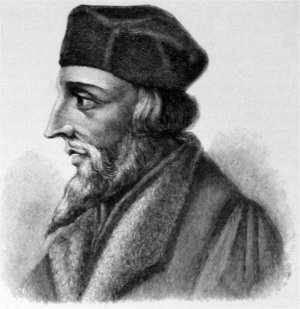
The great success of Hus in his native country was due mainly to his unsurpassed pastoral activity, which far excelled that of the famous old preachers of Bohemia. Hus himself put the highest value on the sermon and knew how to awaken the enthusiasm of the masses. His sermons were often inflammatory as regards their content; he introduces his quarrels with his spiritual superiors, criticizes contemporaneous events, or appeals to his congregation as witness or judge. It was this bearing which multiplied his adherents, and thus he became the true apostle of his English master without being himself a theorist in theological questions.
Other historians would attribute his success to his and his listeners' deep belief in the holy word and the corruption of the Catholic Church.[citation needed] During Hus's trial, he never made claims to originality, but instead advocated a return to the word of the Bible.[citation needed] He continued to repeat that if it could be shown in the Bible that he had erred, that he would gladly recant and be corrected. His single-minded pursuit of the truth was liberating to Europe and was perhaps his greatest legacy.
Hus' friend and devoted follower, Jerome of Prague, shared his fate, although he did not suffer death till nearly a year later, in 1416.
Reference
- Schaff-Herzog: Encyclopedia of Religion
External links
- Final Declaration written on July 1, 1415
Credits
New World Encyclopedia writers and editors rewrote and completed the Wikipedia article in accordance with New World Encyclopedia standards. This article abides by terms of the Creative Commons CC-by-sa 3.0 License (CC-by-sa), which may be used and disseminated with proper attribution. Credit is due under the terms of this license that can reference both the New World Encyclopedia contributors and the selfless volunteer contributors of the Wikimedia Foundation. To cite this article click here for a list of acceptable citing formats.The history of earlier contributions by wikipedians is accessible to researchers here:
The history of this article since it was imported to New World Encyclopedia:
Note: Some restrictions may apply to use of individual images which are separately licensed.
